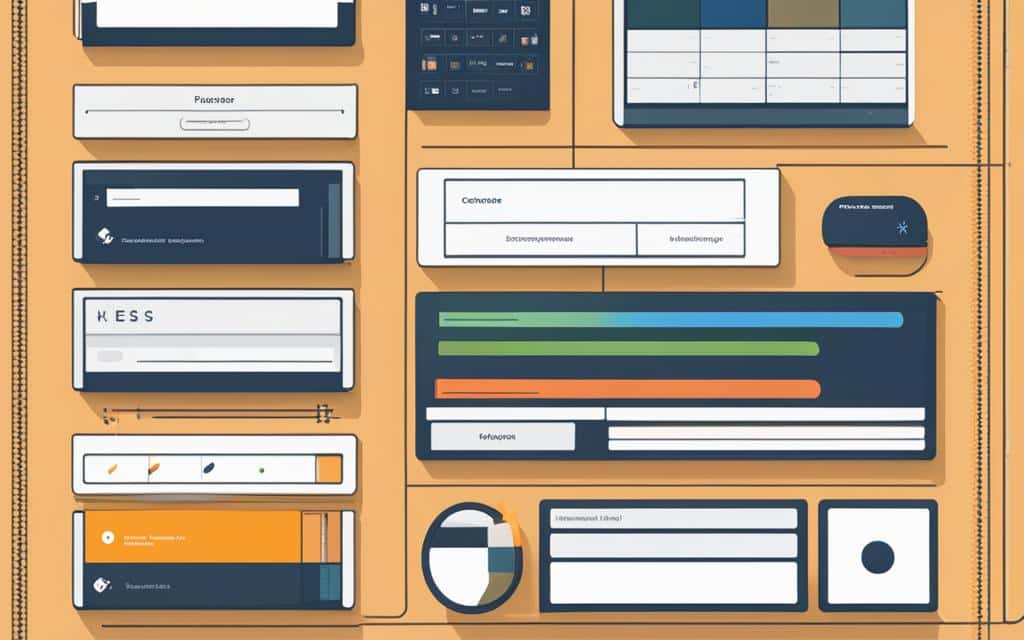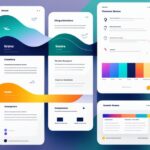Table of Contents
A design system plays a significant role in enhancing user experience (UX) design efficiency and creating optimal UX strategies. By establishing a relationship between design systems and UX design, brands can streamline their design process, improve communication, and ensure visual consistency across all channels and devices.
Design systems are collections of principles that govern the design of a brand’s digital experience. They provide guidelines for how a brand should look and feel, aiming for consistency and efficiency. By using a design system, companies can optimize their UX strategies and deliver exceptional user experiences.
What is a Design System?
A design system is a comprehensive guide for designing digital experiences within a company. It consists of reusable components and clear design guidelines that help ensure consistency and coherence in a company’s products. A design system is not static but rather a living document that evolves as the company grows and changes. It should be flexible enough to accommodate different teams and projects while providing clear direction. In addition to design and code guidelines, mature design systems may also include sections on content, brand, typography, and accessibility.
Benefits of Using a Design System
Using a design system offers numerous benefits for design teams and organizations. It is a powerful tool that enhances communication, efficiency, consistency, scalability, and innovation in the design process. Let’s explore these benefits in detail:
- Improved Communication: Design systems provide a shared language and visual consistency, facilitating effective communication among designers, developers, and stakeholders. By aligning everyone on the same page, teams can collaborate seamlessly and avoid misunderstandings.
- Efficiency: Reusing pre-built components and design patterns from a design system enables designers and developers to work faster and more effectively. This approach reduces technical debt, streamlines the design process, and enhances productivity.
- Consistency: A design system ensures consistency in branding and user experience across different products, channels, and teams. By following established design guidelines and using standardized components, teams can maintain a cohesive brand identity and provide users with a seamless experience.
- Scalability: Design systems are scalable by nature, allowing organizations to accommodate growth and future adaptability. As the system evolves and expands, it can cater to the needs of various projects, teams, and platforms, ensuring a harmonized user experience across the entire organization.
- Innovation: By providing a solid foundation of commonly used components and design principles, a design system frees up time for designers and developers to focus on innovation. With repetitive problems already solved, teams can explore new design ideas and push boundaries, resulting in fresh and innovative solutions.
As you can see, a design system offers a range of benefits that significantly enhance the design process and overall user experience. Let’s take a closer look at some successful examples of design systems in the next section.
At a Glance: Benefits of Using a Design System
| Benefits | Description |
|---|---|
| Improved Communication | Shared language and visual consistency |
| Efficiency | Reduced technical debt and streamlined design process |
| Consistency | Uniform branding and user experience |
| Scalability | Adaptable to diverse projects and platforms |
| Innovation | Time freed up for creative solutions |
Now that we understand the benefits of a design system, let’s explore some successful examples to gain inspiration for implementing our own.
Implementation Tips for Design Systems
When it comes to implementing a design system, it requires a dedicated team and a thoughtful approach. Here are some tips to help you navigate the process effectively:
1. Start with a Pattern Inventory
Before diving into the implementation, it is essential to conduct a pattern inventory. This involves analyzing existing design patterns and components within your organization. By understanding what already exists, you can identify which elements should be included in your design system.
2. Determine Important Components and Variations
Not all components are created equal. Identify the ones that are the most important and require variations based on specific use cases. This will help streamline your design system and avoid unnecessary redundancy.
3. Consolidate Duplicate Components
To ensure a cohesive design system, it is crucial to consolidate any duplicate or overlapping components. This will eliminate confusion and maintain consistency throughout your digital experiences.
4. Include UI Elements, Brand Guidelines, and Content Guidelines
A comprehensive design system should cover various aspects, including UI elements, brand guidelines, and content guidelines. This ensures that all teams are aligned in terms of design and messaging, resulting in a unified user experience.
5. Provide Clear Documentation and Instructions
Clear and concise documentation is key to the successful adoption of a design system. Provide detailed instructions on how to use the components, as well as guidelines for design and development workflows. This will promote consistency and efficiency throughout your organization.
6. Continuously Maintain and Update
Design systems are not one-time projects—they require ongoing maintenance and updates. As your company evolves, so should your design system. Regularly review and refine your components, guidelines, and documentation to ensure they remain relevant and effective.
By following these implementation tips, you can establish a robust and effective design system that improves communication, consistency, and efficiency within your organization.
Examples of Successful Design Systems
Several companies have successfully implemented design systems, serving as excellent examples for inspiration and best practices in the industry. Let’s take a closer look at some of these leading design system examples:
Shopify Polaris
Shopify Polaris is a comprehensive design system that enables Shopify’s merchants to create coherent and visually appealing digital experiences. It provides a robust set of design guidelines, reusable components, and tools to ensure consistency across various applications and platforms. Polaris empowers designers and developers to build user-friendly interfaces that align with Shopify’s brand identity.
IBM Carbon
IBM Carbon is IBM’s design system, designed to create a consistent and accessible user experience across their diverse range of products and services. By leveraging the principles of scalability, modularity, and customization, IBM Carbon allows designers and developers to create seamless interactions that meet the needs of IBM’s high-profile enterprise clients.
Google Material.io
Google Material.io is a design system that fosters intuitive and delightful user experiences across Google’s digital products. By providing a vast library of design guidelines, components, and tools, Material.io enables designers and developers to create applications that adhere to Google’s material design principles. This system ensures consistent branding while allowing for customization based on specific user needs.
Atlassian
Atlassian, the renowned software company, has also implemented a successful design system to enhance their product experiences. By embracing a design system approach, Atlassian maintains a cohesive visual language, streamlined workflows, and consistent user experiences across their popular products like JIRA, Trello, and Confluence. This ensures that users can seamlessly transition between different Atlassian products without any friction.
These design system examples illustrate the boundless potential of implementing well-documented and thoughtfully designed systems. They showcase how leading companies prioritize design consistency, efficiency, and scalability to deliver exceptional user experiences.
While not every organisation can achieve the same level of organisation and documentation as these industry giants, the benefits of design systems are accessible to companies of all sizes. The key is to tailor the design system to the organisation’s unique needs and context, allowing for significant improvements in efficiency, collaboration, and user satisfaction.
Note: Above image visually represents the design systems examples discussed in this section.
| Design System | Key Features |
|---|---|
| Shopify Polaris |
|
| IBM Carbon |
|
| Google Material.io |
|
| Atlassian |
|
Conclusion
In conclusion, design systems play a crucial role in enhancing user experience efficiency. By providing consistent and coherent design guidelines, design systems improve communication and efficiency within design teams. They streamline the design process and ensure visual consistency across different products and channels.
Not only do design systems allow for scalability and future adaptability, but they also free up time for innovation. Although building and maintaining a design system requires effort and a dedicated team, the benefits make it a valuable investment for any organization looking to enhance their UX design strategies.
By implementing a design system, companies can achieve optimal UX strategies and create exceptional user experiences. With the ability to provide clear design guidelines and streamline the design process, design systems pave the way for efficient and consistent user experiences that meet the evolving needs of users.
FAQ
What is a design system?
A design system is a comprehensive guide for designing digital experiences within a company. It consists of reusable components and clear design guidelines that help ensure consistency and coherence in a company’s products.
What are the benefits of using a design system?
Using a design system has several benefits. It improves communication and efficiency by providing a shared language and visual consistency. Designers and developers can work faster and more effectively by reusing pre-built components, reducing technical debt, and streamlining the design process. A design system ensures consistency in branding and user experience across different products, channels, and teams.
How can a design system be implemented effectively?
Implementing a design system requires a dedicated team and a thoughtful approach. It is essential to start with a pattern inventory to understand existing design patterns and components that should be included. Determine which components are the most important and which require variations based on specific use cases. Consolidate duplicate or overlapping components to avoid redundancy. A design system should include UI elements, brand guidelines, and content guidelines. It is important to provide clear documentation and instructions for using the design system, and to continuously maintain and update it as the company evolves.
Can you provide examples of successful design systems?
Several companies have successfully implemented design systems and serve as examples for inspiration. Shopify’s Polaris, IBM’s Carbon, Google’s Material.io, and Atlassian’s design systems are comprehensive and widely used. These examples showcase the possibilities of design systems for different companies and industries.













